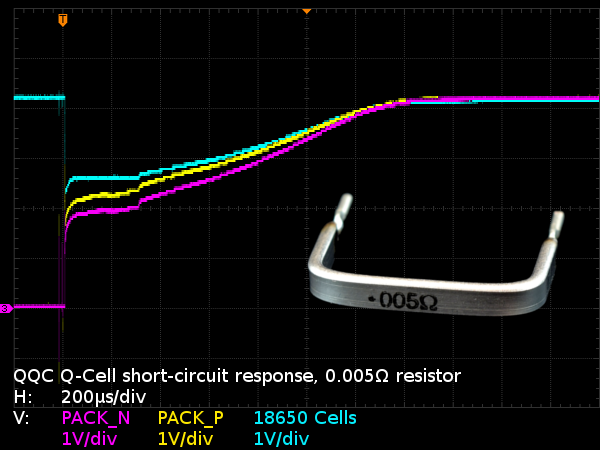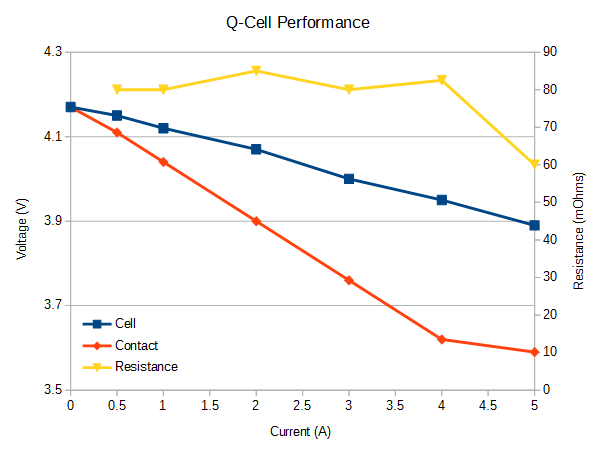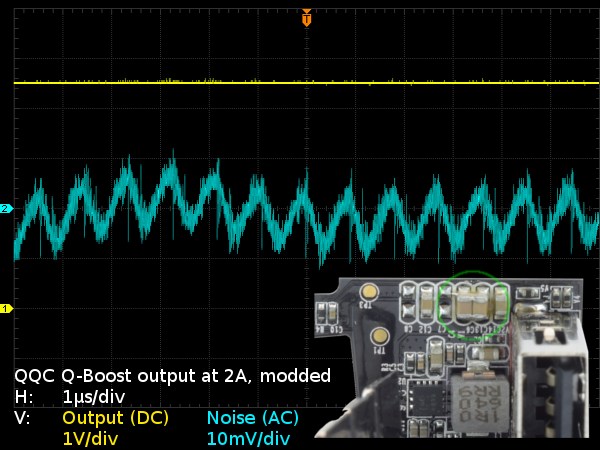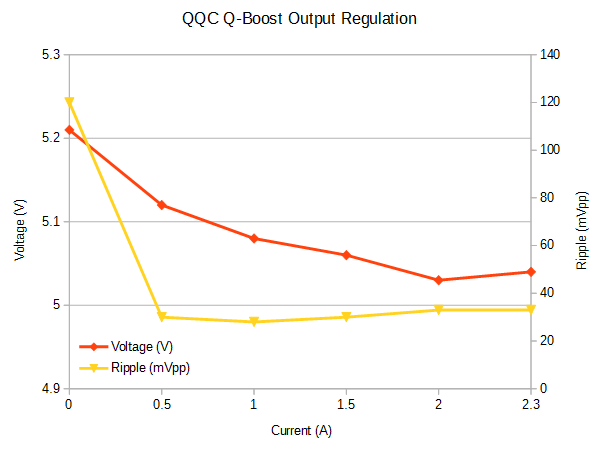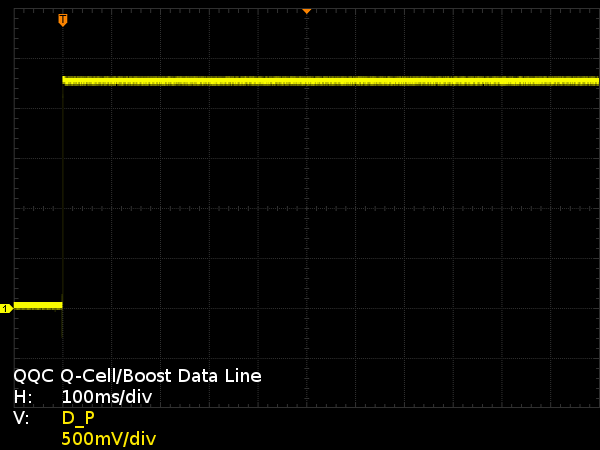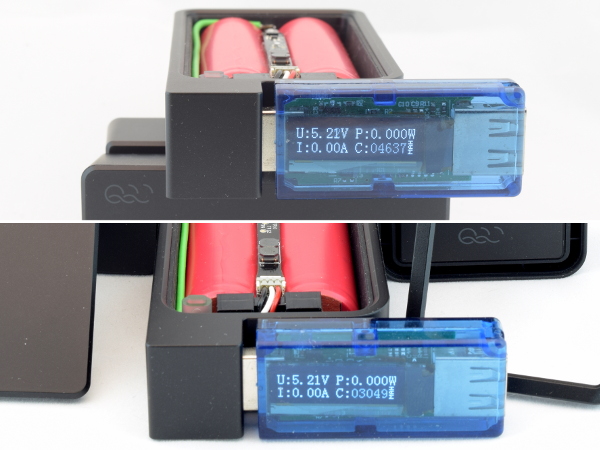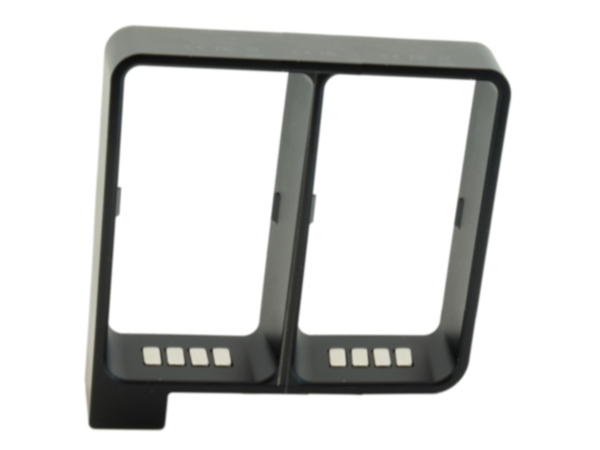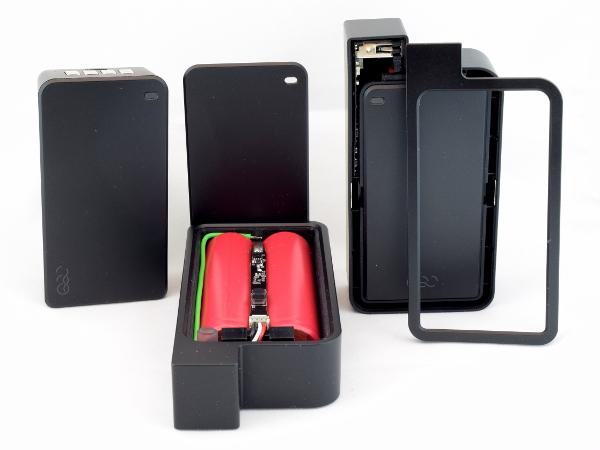QQC Q-Swap Power Bank Tear-Down
Short-Circuit Behavior, Take-II
For this second take, I upgraded to a 0.005Ω shunt resistor to eliminate it as a significant current limiter. I also tracked voltages from the 18650 cells’ negative to cell positive, PACK_N and PACK_P to see how far the cell voltage drops, what the absolute current limit actually is, how much quicker the current limit kicks in, and what the current limit is acting on.
Upon contact, the cell voltage drops from 4.2V to 2.5V while PACK_N rises to 2V, telling us that over-current protection is low-side switched. From the ~400mV difference from PACK_P to PACK_N, we can also deduce that about 80A are flowing through the resistor for the first 800µs, going down from there until it cuts off near the 1.4ms mark. This was enough energy to create a weak spot-weld between my resistor and the Q-Cell contacts.
MORE: SilverStone PB06 USB Power Bank Tear-Down
MORE: Best Deals
Hunting For The Q-Cell’s Limit
After charging the packs overnight, I used a simple adjustable shunt to slowly ramp current up from 0A to the cut-off current while writing down terminal voltages along the way. On the unassembled pack, I also recorded raw cell voltages to determine how much resistance the Q-Cell’s wiring and electronics added. The gap between cell and contact voltage increased by approximately 80mV per ampere, translating to an effective circuit resistance of 80mΩ, or about twice as much as a typical 5A e-fuse. That’s enough to rob you of about 3% of the cell’s capacity.
My unassembled Q-Cell cut off a hair above 5A, while my two factory-assembled units cut off at 5.6A and 5.8A.
MORE: SilverStone PB06 USB Power Bank Tear-Down
Get Tom's Hardware's best news and in-depth reviews, straight to your inbox.
MORE: Best Deals
Q-Boost Output Waveform
What does the Q-Boost output look like? It operates at a switching frequency of about 1 MHz while putting out 2A at 5.03V (it looks like 4.2V here due to wiring losses) and about 30mVpp worth of ripples. Needless to say, I would have been very disappointed if a $120 power bank fell short of its 2.1A rating like most units from my cheap 12V USB adapter round-up last year.
Although 30mVpp is fine, seeing only two out of six populated capacitor footprints on the Q-Boost’s board tells me that the engineers behind it originally aimed for much lower ripples. Let’s see what happens if I outfit my unassembled Q-Boost with some extra caps.
MORE: SilverStone PB06 USB Power Bank Tear-Down
MORE: Best Deals
Modded Output Waveform
I meant to add some 1µF 0603 capacitors like those already in place, but then realized that I had already plucked two capacitors from a strip of 0805 parts instead of 0603s. How much difference does 2µF of extra output filtering capacitance make? Ripples went down from ~32mVpp to ~25mVpp, which is only about 20% better. To get a more significant improvement, I would need to wack a 10µF capacitor in there. Unfortunately, the only ones I have are standard 1210 size and aren’t going to fit.
Practically speaking, 30mVpp is well within “don’t care” territory for USB power, and there is little point in obsessing over it beyond the nagging feeling that it could have been better with $0.02 worth of parts.
MORE: SilverStone PB06 USB Power Bank Tear-Down
MORE: Best Deals
Q-Boost Output Regulation
While the Q-Boost’s 120mVpp noise under no-load condition may not look pretty due to the regulator operating in pulse-skipping mode for low-load efficiency, there is no point in worrying about it when there is nothing plugged in. This pulse-skipping operation continues until about 400mA, albeit with less frequent skips as load increases. From 500mA all the way to its 2.3A cut-off, where you are more likely to use it, the noise remains at a much more respectable 30-33mVpp while the output voltage holds up quite well from 5.21V open-circuit down to 5.04V right before the cut-off. Once tripped, the over-current protection limits the output to 400mA.
I have two minor complaints here: an always-on design slowly drains the cells and poses a potential short-circuit hazard.
MORE: SilverStone PB06 USB Power Bank Tear-Down
MORE: Best Deals
Mystery Data Line
Using aluminum foil strips to access the pads with the Q-Cell installed in the Q-Boost and a strip of paper on the positive pack terminal to keep the Q-Boost frame powered down until I was done setting up the measurement, I recorded the first second of activity after pulling out the paper strip. What did I find? Not much. The “data” pad rises to 2.25V and nothing happens. Leaving my oscilloscope hooked up with a window trigger and faster time base for a few hours didn’t catch anything either.
Instead of a One-Wire chip at the end of the line in the Q-Boost, the steady oddball voltage may point towards a digital potentiometer.
MORE: SilverStone PB06 USB Power Bank Tear-Down
MORE: Best Deals
Charge-Discharge Cycle
How much energy do you get out of a fully charged Q-Cell after the Q-Boost frame? Discharging a fully charged pack at 1A and 5.14V coming out of the Q-Boost yielded 3.049Ah, translating to 15.7Wh. On the charging side of things, it took 4.637Ah at 4.96V (23Wh) to charge it from dead. Pitting energy in against energy out, you get a 69% overall cycle efficiency, which could easily be improved by a few points if QQC simply beefed up the charging circuit’s inductors a little and smoothed out its switching behavior.
While there were no signs of irregular switching behavior in the Q-Boost, it did get warm enough under heavy load to make me think it'd also benefit from a heavier-duty inductor. It has plenty of height clearance to accommodate one, too.
MORE: SilverStone PB06 USB Power Bank Tear-Down
MORE: Best Deals
Natural Progression
At such a jaw-dropping price, there had to be more to the Q-Swap than just its Q-Boost frame. Picking at QQC’s PR representative revealed that these are meant to be pitched at companies who want to have a fleet of interchangeable batteries for their mobile workforce. That still didn’t sound compelling enough to justify the hefty premium over a pair of stand-alone 5Ah power banks. Further digging confirmed that QQC does plan to offer other Q-Cell-powered accessories at some point in the future.
I guessed a few, but QQC asked me not to tell, so I’ll only share what seemed like the most obvious one to me: a multi-cell charging frame to keep your spare cells organized and topped off without a mess of cables.
MORE: SilverStone PB06 USB Power Bank Tear-Down
MORE: Best Deals
To Swap Or Not To Swap
While physical build quality looks and feels quite good, the DC-DC converters’ efficiency and the Q-Cell’s over-current protection could use some work, as 80A shorts across exposed terminals can mar your shiny devices’ metallic surfaces. I consider that a surprising oversight in such an expensive product.
My greatest point of contention with modular battery systems is the availability of accessories powered by them. It is difficult to justify premium pricing for modularity when the only accessory currently available makes the product functionally comparable to stand-alone power banks costing a fraction as much.
Ignoring the Q-Swap’s price, as it clearly isn’t intended for budget-conscious buyers, what sort of must-have accessory would make you consider buying into such a system?
MORE: SilverStone PB06 USB Power Bank Tear-Down
MORE: Best Deals
-
JamsCB Interesting idea, but by going with this design of a spare battery with exposed contacts means you're going to have to do something with that extra battery if you want to fly anywhere, at least in the US (See the regulation: 49 CFR 175.10(a)(18) ). Personally I feel if you need that much spare charge, two separate banks would be the simpler and cheaper option.Reply -
sparkyman215 Asus makes a great battery pack with 10k mAh, and it's only $20. I've had mine for maybe a year and it hasn't exploded yetReply -
LostAlone Feels like this is entirely misguided on their part. Battery packs are bulk commodity items now, they've become cheap and ubiquitous. Everyone has their own branded ones out there. And with that in mind, I just don't understand an expensive version. Honestly, even in the corner case that you need so much juice that multiple battery packs are reasonable then I'd rather have another complete back with it's extra ports available. Sure, a little more bulk but only slightly and this gives me a truly redundant solution that I can lend to someone or have a complete spare in the event of loss or damage.Reply
In the end, given that battery packs are already light and small making a lighter smaller one isn't that big a deal. Any thing in the 10k mAh range is too big to keep in a pocket all day anyway, and once you're tossing the things in a bag then it really doesn't matter if it's a little big smaller or lighter. -
Daniel Sauvageau Reply
People stuff 6" 'phones' in their pockets. I've seen 10Ah power banks smaller than those but haven't tested one yet to see if they can actually deliver. I do plan to address that later this year.19802041 said:Any thing in the 10k mAh range is too big to keep in a pocket all day anyway
-
nukemaster Another good one.Reply
Looking forward to seeing your tests on some of those smaller 10Ah ones you mention. I rarely need an on the go charge(my old Zen did sometimes when I forgot to charge it), but it is always nice to have 5 volts for testing things. -
LostAlone ReplyPeople stuff 6" 'phones' in their pockets. I've seen 10Ah power banks smaller than those but haven't tested one yet to see if they can actually deliver. I do plan to address that later this year.
Phones have a bigger footprint but a 10k or 12k battery back is MUCH thicker and MUCH heavier. Take it from someone with a big phone AND a 12k battery pack; only one of those happily lives in my pocket all day. Maybe on something with cargo pockets you could stick the battery in a pocket but it wouldn't be comfortable to sit on it.
My battery pack is almost an inch thick dude; and totally inflexible and heavy enough that it can pull your pants down. It's a whole other kettle of fish compared to a phone, even a big phone. -
alextheblue I'll just shove this into my pocket with loose change...Reply
They need some kind of spring-loaded safety cover for those contacts, and at that price I would want so much more than what they're offering. Standard cylindrical cells? I would expect it to be using fancier (and higher density) packs using semi-prismatic cells or maybe higher-end well-engineered pouch cells.. Maybe support for Qi charging and higher amp output / higher volt QC capabilities. Otherwise... it's really no better than a typical 5200 pack in the $30 range. -
Daniel Sauvageau Reply
That depends heavily on the type of cells being used and by type, I mean the actual chemistry and geometry of the cell which dictate the cell's maximum charge/discharge current, cycle endurance and nominal capacity. There is a drastic energy density difference between high current, high endurance cells (thicker current-carrying electrodes and anode/cathode material) and those prioritizing energy density over all else.19805518 said:Phones have a bigger footprint but a 10k or 12k battery back is MUCH thicker and MUCH heavier.
Also, a power bank designed around pouch-style cells isn't constrained by the size of 18650 cells and can be made much thinner. -
Daniel Sauvageau Reply
Based on my limited short-circuit tests, that should actually be fine as the output cuts off within 2ms from the short being detected and wouldn't cause your change to warm up noticeably.19805743 said:I'll just shove this into my pocket with loose change...
Still, I am disappointed that there wasn't some sort of protocol between the pack and frame to limit current until the connection to an accessory is confirmed.
